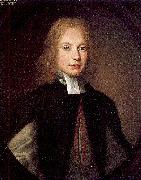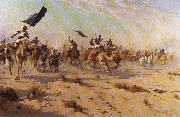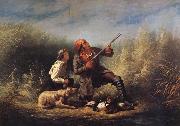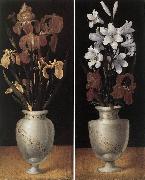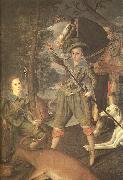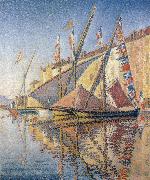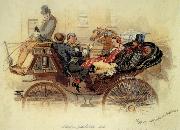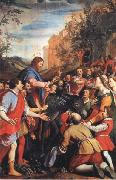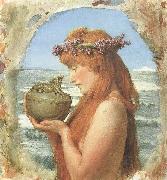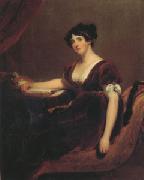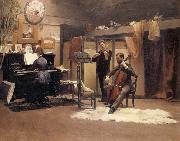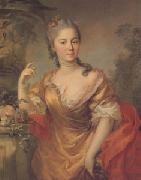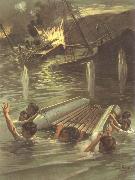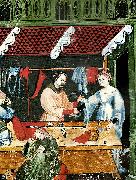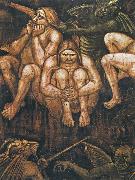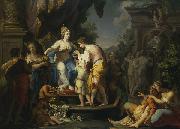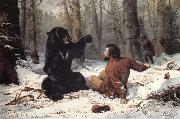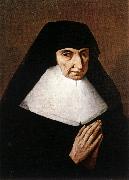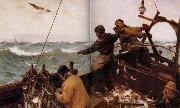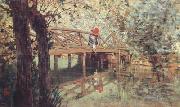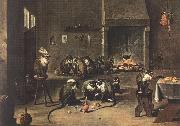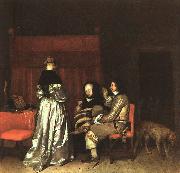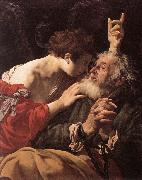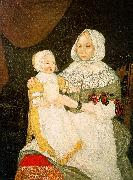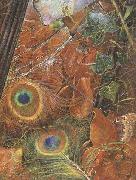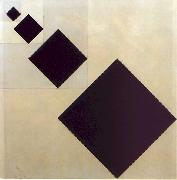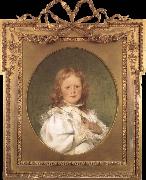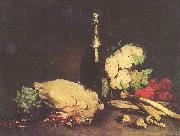|
|
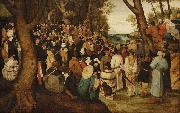 |
Pieter Brueghel the Younger
|
|
(1564 or 1565 - 10 October 1636) was a Flemish painter, known for numerous copies after his father Pieter Brueghel the Elder's paintings and nicknamed "Hell Brueghel" for his fantastic treatments of fire and grotesque imagery.
Pieter Brueghel the Younger was the oldest son of the famous sixteenth-century Netherlandish painter Pieter Brueghel the Elder (known as "Peasant Brueghel") and Mayken Coecke van Aelst. His father died in 1569, when Pieter the younger was only five years old. Then, following the death of his mother in 1578, Pieter, along with his brother Jan Brueghel the Elder ("Velvet Brueghel") and sister Marie, went to live with their grandmother Mayken Verhulst (widow of Pieter Coecke van Aelst). She was an artist in her own right, and according to Carel van Mander, possibly the first teacher of the two sons. The family moved to Antwerp sometime after 1578 and Pieter possibly entered the studio of the landscape painter Gillis van Coninxloo (1544 - 1607). In the 1584/1585 registers of Guild of Saint Luke, "Peeter Brugel" is listed as an independent master. On 5 November 1588 he married Elisabeth Goddelet, and the couple had seven children.
He painted landscapes, religious subjects and fantasy paintings. For this last category he often made use of fire and grotesque figures, leading to his nickname "Hell Brueghel".
Apart from these paintings of his own invention, Pieter Brueghel the Younger also copied the works his father had created by using a technique called pouncing. His genre paintings of peasants lack Pieter the Elder's subtlety and humanism, and emphasize the picturesque
|
|
|
|
|
|
|
|
|
|
|
|
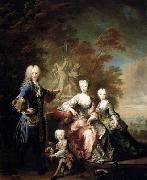 |
Robert Levrac Tournieres
|
|
Thomas William Robertson (9 January 1829 ?C 3 February 1871), usually known professionally as T. W. Robertson, was an Anglo-Irish dramatist and innovative stage director best known for a series of realistic or naturalistic plays produced in London in the 1860s that broke new ground and inspired playwrights such as W.S. Gilbert and George Bernard Shaw. |
|
|
|
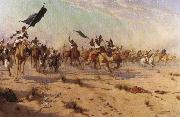 |
Robert Talbot Kelly
|
|
(1861 - 1934) was an English orientalist landscape and genre painter, author and illustrator.
Kelly was born in Birkenhead, Cheshire, the son of Irish landscape artist Robert George Kelly. He left school in 1876 to take up work in a firm of cotton traders, but was also taught art by his father, exhibiting under the name R. G. Kelly Jnr.
In the early 1880s, inspired by the places he saw while on vacation on an ocean cruise ship, Talbot-Kelly decided to take up his father's profession. He left his employment in 1882, travelled by boat to North Africa, and settled in Egypt in 1883, acquiring a studio in Cairo and becoming fluent in Arabic. He travelled throughout the country, writing about and painting the people and scenes he encountered both in towns and in the desert. He spent a considerable time with the Bedouin tribes who he described and illustrated in his 1902 book, "Egypt painted and described" (A & C Black). As his name became known he also earned an income from private commissions. He stayed in Egypt until 1915 when for reasons of health and age he returned to London - though he continued to paint constantly.
An Arab cafe in Cairo (from "Egypt painted and described", 1902)"Egypt painted and described", his first illustrated travel book, was published in 1902 (by A & C Black), and was an account of his impressions and experiences of that country during his long stay there; an exhibition of his Egyptian views was also held at the Fine Art Society in the same year. His paintings and writing showed a great empathy and respect for local people and culture, especially that of the desert Bedouin Arabs. |
|
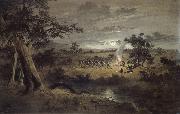 |
S.T.Gill
|
|
Australian original water-colour drawings and prints
b.1818-d.1880
|
|
|
|
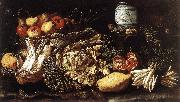 |
SALINI, Tommaso
|
|
Italian painter, Roman school (b. 1575, Roma, d. 1625, Roma).
|
|
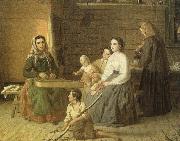 |
samuel taylor coleridge
|
|
Born: 21 October 1772
Birthplace: Devonshire, England
Died: 25 July 1834 (heart attack)
Best Known As: The author of The Rime of the Ancient Mariner |
|
|
|
|
|
|
|
|
|
|
|
|
|
|
|
|
|
|
|
|
|
|
|
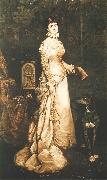 |
Tadeusz Ajdukiewicz
|
|
1852 in Wieliczka ?C January 9, 1916 in Krak??w) was a Polish painter.
From 1868 to 1873, he followed Władysław Luszczkiewicz classes in the Fine art school of Krakow. Later, he was in Vienna and Munich and in J??zef Brandt's atelier. In 1877, he travelled to Paris and Near East. In 1882, he lived in Vienna, where he worked for the aristocracy. In 1883, he went to London, where he made Prince of Wales' portrait. In 1884, to Constantinople, he was sultan Abdhulhamid II's guest. And he woked later in Sofia, Saint Petersburg and Bucharest. He joined the Polish Legions in 1914, during World War I, and he died in one of the battles of this war. He's first cousin was Zygmunt Ajdukiewicz. |
|
|
|
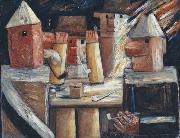 |
Tadeusz Makowski
|
|
(21 January 1882 - 1 November 1932) was a prominent Polish painter active in France for most of his life. He was born in Oświęcim. Makowski attended the Academy of Fine Arts in Krakew. He studied under Jan Stanisławski and Jezef Mehoffer. In 1909, he departed for Paris. Makowski started off as a landscape painter but then shifted towards Post-Impressionism and Cubism. However, he is arguably most famous for his rural landscape paintings. He met Pablo Picasso,who was his good friend.
|
|
|
|
|
|
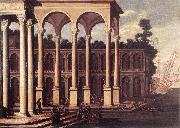 |
TASSI, Agostino
|
|
Italian painter, Roman school (b. 1578, Roma, d. 1644, Roma).
|
|
|
|
 |
tchaikovsky
|
|
Born: 7 May 1840
Birthplace: Votkinsk, Russia
Died: 6 November 1893
Best Known As: Russian composer of The Nutcracker |
|
|
|
|
|
|
|
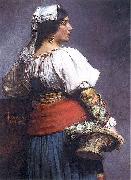 |
Teodor Axentowicz
|
|
born May 13, 1859 in Braşov, Romania - August 26, 1938 in Krakew) was a Polish-Armenian painter and university professor. A renowned artist of his times, he was also the rector of the Academy of Fine Arts in Krakew. As an artist, Axentowicz was famous for his portraits and subtle scenes of Hutsul life, set in the Carpathians.
Axentowicz was born May 13, 1859 in Braşov, Hungary (now Romania), to a family of Polish-Armenian ancestry. In 1893 in Chelsea, London, he married Iza Henrietta Gielgud, aunt of Val Gielgud and John [Arthur] Gielgud of the theatrical dynasty. A son, Philip S.A.D. Axentowicz was born in Chelsea in 1893.
Between 1879 and 1882 he studied at the Academy of Fine Arts in Munich. From there he moved to Paris, where he continued his education until 1895. During that time he started a long-time cooperation with various journals and started his career as a copyist, duplicating the works of Tizian and Botticelli. He also made numerous travels to London and Rome, where he prepared a set of portraits, one of the first in his career.
|
|
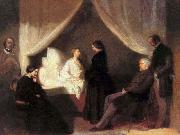 |
Teofil Kwiatkowski
|
|
(February 21, 1809, Pułtusk - August 14, 1891, Avallon, France) was a Polish painter.
Kwiatkowski participated in the November 1830 Uprising. After its suppression, he emigrated to France.
His artistic work includes many images of Frederic Chopin, including a picture of him playing at a ball at Paris's Hôtel Lambert and Chopin on His Deathbed (1849).
|
|
|
|
|
|
|
|
|
|
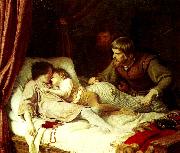 |
th. hildebrandt
|
|
Ferdinand Theodor Hildebrandt, född 2 juli 1804 i Stettin, död 29 september 1874 i Dusseldorf, var en tysk målare.
Hildebrandt började sina konstnärliga studier i Berlin under Wilhelm Schadow, vilken han 1826 följde till Dusseldorf, och blev en av den där grundade skolans mest framstående lärjungar. 1825 framträdde han med Faust, 1826 med Cordelia och kung Lear och 1828 med Tankred döpande Klorinda. Ännu större popularitet vann han 1835 för Mordet på kung Edvards söner. Bland hans genrebilder har i synnerhet Krigaren och hans son (1832, Berlins nationalgalleri) blivit känd. Hildebrandt, som för övrigt utförde illustrationer och porträtt, kallades på sin tid realist, men han var knappast fri från den melodramatiska ton och den sentimentala inställning, som tillhörde skolan. |
|
|
|
|
|
|
|
|
|
|
|
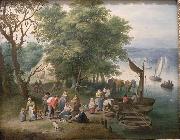 |
Theobald Michau
|
|
Michau (1676 Tournai - Antwerp 1765) was a conservative Flemish painter of landscapes, more famous in his own time than he is today. He was a pupil of Lucas Achtschellinck.
Subjects of the country festivals (Kermesse) that were popularized by David Teniers, father and son to the extent that paintings and tapestries showing such rustic themes were called Tenieres. Michau painted designs and perhaps provided full-scale cartoons for tapestry weavers, for surviving records of the Brussels tapestry workshop of Pieter van der Borcht record Teniers peints par le fameux Sr Michau, such Teniers-like subjects painted by "the famous Sieur Michau".
Among his work, on wooden or copper panels, in public collections are the Summer and Winter landscapes in Vienna
|
|
|
|
|
|
|








